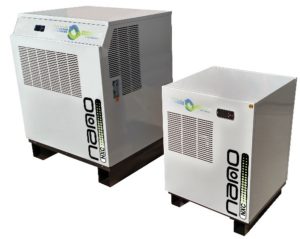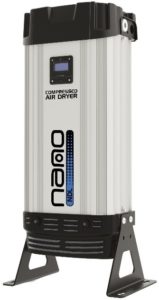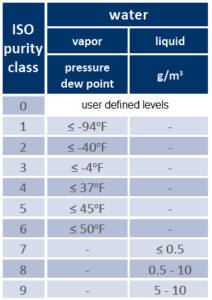 Compressed air is commonly referred to as the 4th utility, which is why facility managers are concerned with the quality and moisture content of the air going into their plant. High levels of moisture (water and oil) can cause premature wear on tools, cylinders and valves as well as increase corrosion and bacteria/mold growth inside the piping network. Installing a compressed air dryer will drastically reduce the moisture content and eliminate these problems; however, selecting the correct dryer technology is important.
Compressed air is commonly referred to as the 4th utility, which is why facility managers are concerned with the quality and moisture content of the air going into their plant. High levels of moisture (water and oil) can cause premature wear on tools, cylinders and valves as well as increase corrosion and bacteria/mold growth inside the piping network. Installing a compressed air dryer will drastically reduce the moisture content and eliminate these problems; however, selecting the correct dryer technology is important.
Refrigerated style compressed air dryers are common and operate similarly to an air conditioning unit by cooling the incoming compressed air, condensing water vapor into liquid and then removing through a separator with a drain valve. Refrigerated dryers are limited by temperature and cannot cool below 32°F (0*C), as the condensed liquid would freeze. Pressure dew point is defined as the temperature at which water vapor condenses into a liquid at a given pressure. Based on this definition, a refrigerated dryer will deliver a pressure dew point range just above 32°F. As a reference, compressed air at 38°F pressure dew point and 100 psig pressure contains 609 ppm(w) of moisture.
Types of Refrigerated Air Dryers
There are several different types of refrigerated dryers including non-cycling, cycling and variable speed dryers. Each technology refers to the operation of the refrigeration compressor. The compressor runs continuously in a non-cycling dryer, independent of the thermal load. Similar to your home refrigerator or air conditioning unit, a cycling dryer turns the refrigeration compressor on and off based on a varying system thermal load. Your home is the thermal mass for your air conditioning unit which allows the compressor to cycle on and off. Cycling compressed air dryers utilize a thermal mass such as silica or glycol to cycle the refrigeration compressor and a variable speed drive compressor increases or decreases the speed and subsequent capacity of the compressor relative to the compressed air consumption.
To achieve a pressure dew point below 32°F, a different technology known as adsorption is required. Small beads or granules of desiccant material are extremely effective in removing moisture, similar to the small bags you might find in a new pair of shoes or jacket pocket. In the adsorption process, the desiccant media pulls the moisture out of the compressed air stream and holds it on the surface of the beads. Over time, the beads become saturated and require regeneration. During this phase of the process (commonly referred to r egeneration or desorption), a portion of the dried air from the online tower/vessel is used to flow through the saturated tower to remove the moisture. As a reference, compressed air at a -40°C/F pressure dew point and 100 psig pressure contains 10 ppm(w) moisture content and meets ISO 8573 class 2.
egeneration or desorption), a portion of the dried air from the online tower/vessel is used to flow through the saturated tower to remove the moisture. As a reference, compressed air at a -40°C/F pressure dew point and 100 psig pressure contains 10 ppm(w) moisture content and meets ISO 8573 class 2.
The ISO 8573 group of international standards is used for the classification of compressed air purity. The standard provides the test methods and analytical techniques for each type of contaminant. The table to the left summarizes the maximum contaminant levels specified in ISO 8573.1: 2010 for the various compressed air quality classes.
Nano-Purification Dryer Solutions
Nano R1-Series (NXC) thermal mass refrigerated dryers utilize a reliable, simple and energy-efficient stationary silica mass dryer design to achieve a 38°F pressure dew point (ISO Class 4 moisture vapor). If you require a lower pressure dew point for high technology lab or process applications, the nano D-Series (NDL, NHL, NEX and NBP) utilize highly efficient desiccant and advanced controls to effectively remove moisture content down to a -40°C/F pressure dew point or lower (ISO Class 2/1 moisture vapor). Contact your local compressed air professional at Lewis Systems to find out which dryer technology is right for your specific application at your facility.
Guest post written by: Mark Lauterwasser, Business Development Manager at nano purification solutions. For more information, visit www.n-psi.com.


